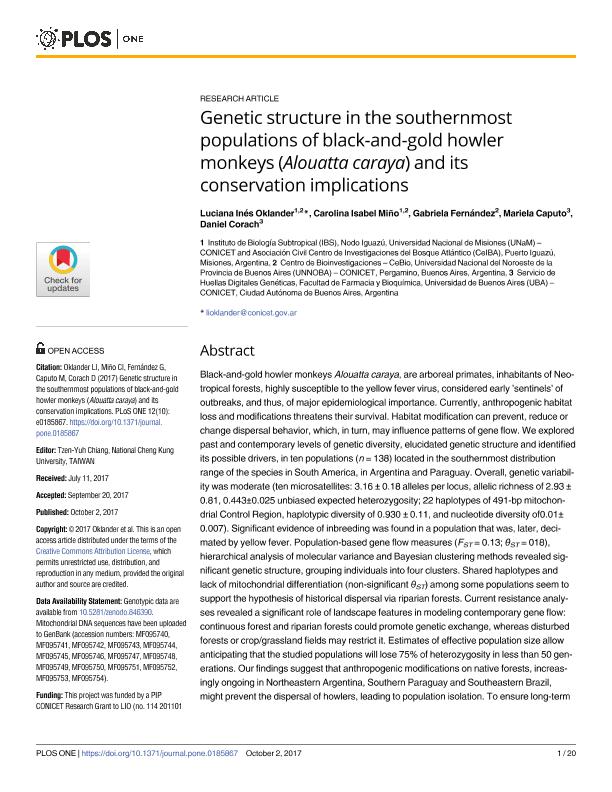Artículo
Genetic structure in the southernmost populations of black-and-gold howler monkeys (Alouatta caraya) and its conservation implications
Oklander, Luciana Inés ; Miño, Carolina Isabel
; Miño, Carolina Isabel ; Fernández, Gabriela; Caputo, Mariela
; Fernández, Gabriela; Caputo, Mariela ; Corach, Daniel
; Corach, Daniel
 ; Miño, Carolina Isabel
; Miño, Carolina Isabel ; Fernández, Gabriela; Caputo, Mariela
; Fernández, Gabriela; Caputo, Mariela ; Corach, Daniel
; Corach, Daniel
Fecha de publicación:
10/2017
Editorial:
Public Library of Science
Revista:
Plos One
ISSN:
1932-6203
Idioma:
Inglés
Tipo de recurso:
Artículo publicado
Clasificación temática:
Resumen
Black-and-gold howler monkeys Alouatta caraya, are arboreal primates, inhabitants of Neotropical forests, highly susceptible to the yellow fever virus, considered early ´sentinels´ of outbreaks, and thus, of major epidemiological importance. Currently, anthropogenic habitat loss and modifications threatens their survival. Habitat modification can prevent, reduce or change dispersal behavior, which, in turn, may influence patterns of gene flow. We explored past and contemporary levels of genetic diversity, elucidated genetic structure and identified its possible drivers, in ten populations (n = 138) located in the southernmost distribution range of the species in South America, in Argentina and Paraguay. Overall, genetic variability was moderate (ten microsatellites: 3.16 ± 0.18 alleles per locus, allelic richness of 2.93 ± 0.81, 0.443±0.025 unbiased expected heterozygosity; 22 haplotypes of 491-bp mitochondrial Control Region, haplotypic diversity of 0.930 ± 0.11, and nucleotide diversity of0.01± 0.007). Significant evidence of inbreeding was found in a population that was, later, decimated by yellow fever. Population-based gene flow measures (FST = 0.13; θST = 018), hierarchical analysis of molecular variance and Bayesian clustering methods revealed significant genetic structure, grouping individuals into four clusters. Shared haplotypes and lack of mitochondrial differentiation (non-significant θST) among some populations seem to support the hypothesis of historical dispersal via riparian forests. Current resistance analyses revealed a significant role of landscape features in modeling contemporary gene flow: continuous forest and riparian forests could promote genetic exchange, whereas disturbed forests or crop/grassland fields may restrict it. Estimates of effective population size allow anticipating that the studied populations will lose 75% of heterozygosity in less than 50 generations. Our findings suggest that anthropogenic modifications on native forests, increasingly ongoing in Northeastern Argentina, Southern Paraguay and Southeastern Brazil, might prevent the dispersal of howlers, leading to population isolation. To ensure long-term viability and maintain genetic connectivity of A. caraya remnant populations, we recommend preserving and restoring habitat continuity. To conserve the species genetic pool, as well, the four genetic clusters identified here should be considered separate Management Units and given high conservation priority. In light of our findings and considering complementary non-genetic information, we suggest upgrading the international conservation status of A. caraya to ?Vulnerable?.
Palabras clave:
Genetic Differentiation
,
Monos Aulladores
,
Molecular Markers
,
Primates
Archivos asociados
Licencia
Identificadores
Colecciones
Articulos(CCT - NORDESTE)
Articulos de CTRO.CIENTIFICO TECNOL.CONICET - NORDESTE
Articulos de CTRO.CIENTIFICO TECNOL.CONICET - NORDESTE
Articulos(IBS)
Articulos de INSTITUTO DE BIOLOGIA SUBTROPICAL
Articulos de INSTITUTO DE BIOLOGIA SUBTROPICAL
Citación
Oklander, Luciana Inés; Miño, Carolina Isabel; Fernández, Gabriela; Caputo, Mariela; Corach, Daniel; Genetic structure in the southernmost populations of black-and-gold howler monkeys (Alouatta caraya) and its conservation implications; Public Library of Science; Plos One; 12; 10; 10-2017; 1-20; e0185867
Compartir
Altmétricas



